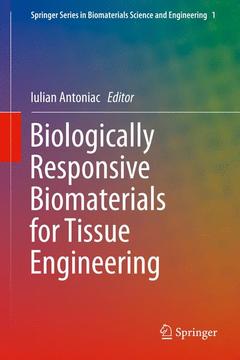Description
Biologically Responsive Biomaterials for Tissue Engineering, 2013
Springer Series in Biomaterials Science and Engineering Series, Vol. 1
Language: English
Subjects for Biologically Responsive Biomaterials for Tissue Engineering:
Keywords
Carbon Nanotubes Acrylic Bone Cement; Molecular Scissors; Scaffold Design Bone Tissue Engineering; Synthetic Morphogens and Pro-morphogens; bioabsorbable interference screws; bioadhesives; biomaterials tissue engineering; biomedical engineering; biomedical nanotechnology book; bionanotechnology book; bionanotechnology diagnostic devices; biotechnology restriction enzymes; endothelial cells response to metals; hydrogels in rapid prototyping; modelling and numerical analysis orthopaedic applications; regenerativ
Publication date: 10-2014
254 p. · 15.5x23.5 cm · Paperback
Publication date: 09-2012
254 p. · 15.5x23.5 cm · Paperback
Description
/li>Contents
/li>Comment
/li>
Developments in the area of biomaterials, bionanotechnology, tissue engineering, and medical devices are becoming the core of health care. Almost all medical specialties involve the use of biomaterials, and research plays a key role in the development of new and improved treatment modalities. This volume focuses on several current trends in tissue engineering, remodelling and regeneration. Leading researchers describe the use of nanomaterials to create new functionalities when interfaced with biological molecules or structures. In addition to coverage of basic science and engineering aspects, a range of applications in bionanotechnology are presented, including diagnostic devices, contrast agents, analytical tools, physical therapy applications, and vehicles for targeted drug delivery. The use of polymers, alloys, and composites, or a combination of these, for biomaterials applications in orthopaedics is also explored. These contributions represent essential reading for the biomaterials and biomedical engineering communities, and can serve as instructional course lectures targeted at graduate and post-graduate students.
Preface
Chapter 1 Scaffold Design For Bone Tissue Engineering: From Micrometric To Nanometric Level
1.1 Introduction
1.2 Scaffold Design: basic criteria
1.3 Designing microstructure
1.3.1 Hierarchically organized architecture
1.3.2 Multi-scale degradation
1.4 Surface and bulk bioactivation
1.5 Designing nanostructures
1.5.1 Micro or nanotexture?
1.5.2 Chemical cues for cell recognition
1.6 Conclusion
1.7 References
Chapter 2 Molecular Scissors - from Biomaterials Implant to Tissue Remodeling
2.1 Introduction
2.2 Extracellular matrix tailoring by specific means
2.3 Proteases and MMPs family
2.4 MMPs activity depends on catalytic domain structure and behavior
2.5 MMPs natural inhibitors
2.6 MMPs in wound repair
2.7 MMPs in epithelial repair
2.8 MMP involvement in resolution step of wound healing
2.9 TIMPs in wound repair
2.10 Evaluation of immunohistochemical detection of MMPs in periimplant tissues
2.11 Summary
2.12 References
Chapter 3 Synthetic Morphogens and Pro-morphogens for Aided Tissue Regeneration
3.1 Introduction: morphogen definition
3.2 Morphogens in vertebrates
3.3 Morphogen long-distance transport and local mechanisms
3.4 Growth factors as morphogens
3.5 Knowledge in developmental biology: lessons for therapeutically-driven tissue regeneration
3.6 Growth factors in adult tissue repair and regeneration
3.6.1 Use of growth factors in clinical intervention
3.6.2 Limitation in the use of growth factors in clinical intervention
3.7 Synthetic morphogens, growth factors and bioligands
3.7.1 Identification of bioactive sequences by phage displayed peptide technique
3.8 Current limitations and future strategies to improve the therapeutic potential of analogue morphogens, growth factors and bioligands
3.8.1 Current limitations
3.8.2 Future strategies
3.9 Conclusions
3.10 References
Chapter 4 The role of oxidative stress in the response of endothelial cells to metals
4.1 Metallic materials for implantation
4.2 Aseptic loosening and metal corrosion
4.3 Integration of metal implants and the role of endothelial cells
4.4 Oxidative stress: ROS formation and antioxidant defence mechanisms
4.5 Ti6Al4V-induced oxidative stress
4.6 Cathodic half-reaction of corrosion as the possible source of oxidative stress on Ti6Al4V alloy
4.7 Summary
4.8 References
Chapter 5 Comparative properties of ethyl, n-butyl and n-octyl cyanoacrylate bioadhesives intended for wound closure
5.1 Introduction
5.2 Experimental
5.2.1 Materials
5.2.2 Experimental techniques
5.3 Results and discussion
5.4 Conclusions
5.5 References
Chapter 6 Development of bioabsorbable interference screws – how influence biomaterials composition, clinical and retrieval studies the innovative screw design and manufacturing processes
6.1. Introduction
6.2. Interference screws classification and design
6.3. New design for a bioresorbable interference screw
6.3.1 Clinical and retrieval study
6.3.2. Innovative design of a bioresorbable interference screw
6.3.3 Discussion about the functionality of the new design for bioresorbable interference screw
6.4. Biodegradable interference screws manufacturing processes
6.5 Conclusions
6.6. References
Chapter 7 Modeling And Numerical Analysis Of A Cervical Spine Unit
7.1 Introduction
7.2 Solid Reconstruction Modeling of a Cervical Vertebra
7.2.1 Image Acquisition
7.2.2 Image Processing
7.2.3 Surface Generation
7.2.4 Solid Generation
7.3 Classical Geometric Modeling of a Functional Implanted Unit C2-C3
7.4 Simulation of Mechanical Behavior for Implanted Cervical Unit
7.4.1 FEA Main Stages
7.4.2 Mechanical Effects at the Bone – Screw Interfaces
7.5 Conclusions
7.6 References
Chapter 8 Carbon Nanotubes in Acrylic Bone Cement
8.1 The Hip Joint
8.1.1 Potential Problems with the Hip Joint and Primary Joint Replacement
8.2 Acrylic Bone Cement
8.2.1 Composition
8.2.2 Polymerisation Reaction
8.2.3 Thermal and Chemical Necrosis
8.2.4 Mechanical Properties
8.2.5 Biocompatibility of Bone Cement In Vivo
8.2.6 Effect of Residual Stresses and Cement Shrinkage
8.2.7 The Role of Porosity
8.3 Reinforcement of Bone Cement
8.3.1 Developments in Acrylic Bone Cement
8.3.2 Mechanical Performance
8.3.3 Biological Performance
8.3.4 Polymer Matrix Composites
8.3.5 Carbon Nanotubes
8.3.6 CNT-Reinforced Biomaterials
8.4 Biocompatibility of CNTs
8.5 Summary
8.6 References
9.1 Introduction
9.2 ECM mimetics: current concepts
9.2.1 Scaffold-based vs. scaffold-free TE
9.2.2 Scaffolds
9.2.3 Controlling the external and internal geometry
9.3 Rapid prototyping hydrogels: powerful aid in making scaffold-based tissue engineering work
9.3.1 Laser-based systems
9.3.2 Nozzle-based systems
9.3.2 Printer-based systems
9.4 Preserving the mechanical integrity of RP processed hydrogels
9.5 Fundamentals on rapid prototyping in scaffold-free tissue engineering
9.6 Future directions
9.7 References
Includes the latest results in highly interdisciplinary aspects of the field such as synthetic morphogens and promorphogens in tissue regeneration, the use of restriction enzymes, and endothelial cell response to metals
Presents cutting-edge research on scaffold design and processing for bone tissue engineering, and biodegradable and biocompatible composites in orthopaedic applications
Discusses state-of-the-art developments in treatment and diagnostics
Highlights practical aspects of rapid prototyping in developing new implants
Organized for use as instructional course lectures
Includes supplementary material: sn.pub/extras




